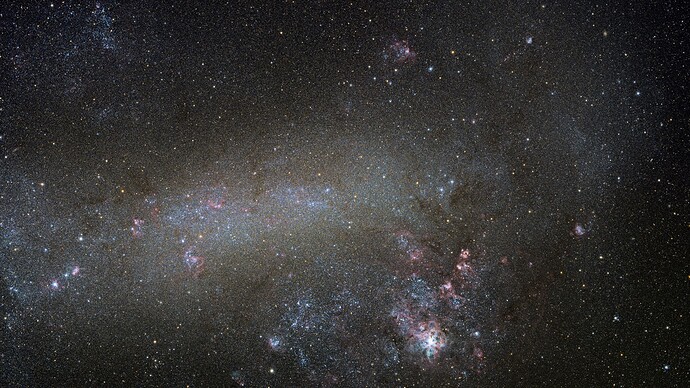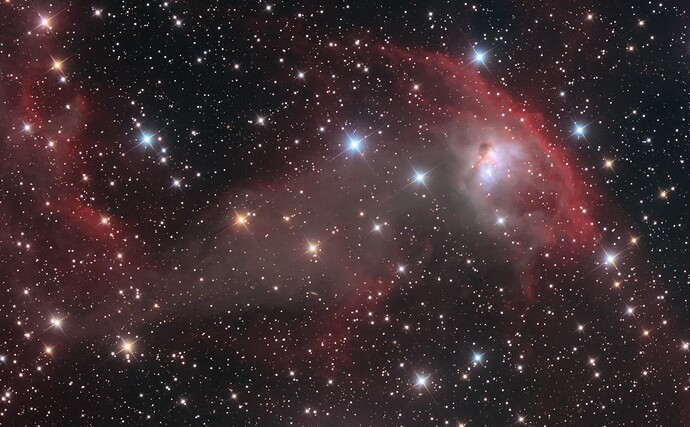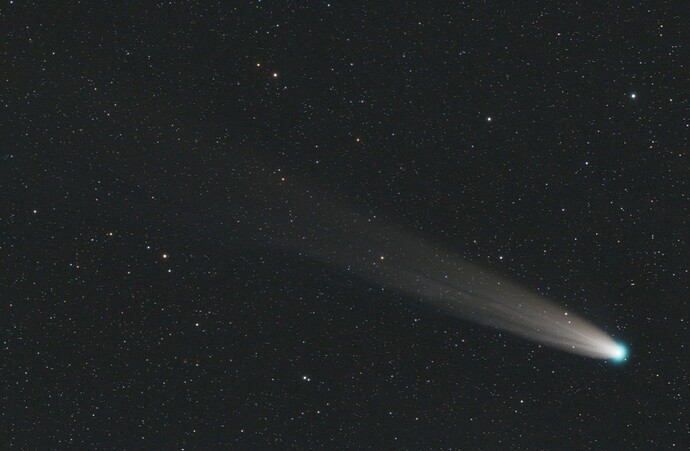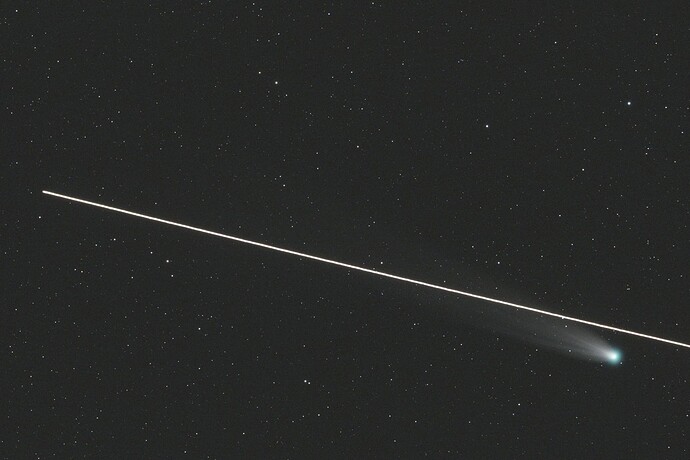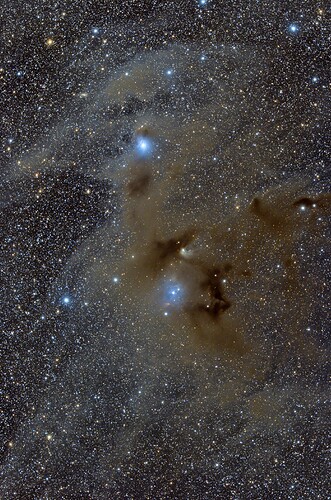Fantastic work! The Helix looks fantastic.
Wonderful image Paul.
Thanks for sharing.
All the best
Leonardo
Thank you both, I am quite happy with this one. The weather here has been quite challenging to image through for the last six months so anything that needs more than a couple of nights to shoot is a bit of an achievement. I am in the Eastern part of Australia and they are predicting a wet spring and summer too!
Another I have been working on for a few weeks, this one shot with the Stellarvue SVX80T and the ASI2600MC camera. Initially I shot a single panel on the Tarantula nebula but there was a string of clear nights expected so I reframed with the virtual FOV tool to make a mosaic of the Large Magellanic Cloud.
It is harder to do when you have already shot one panel but you can start with a single and change to a mosaic, so long as you add an even number of panels (E.G. start with a single panel and then make it a 3 X 5 panel or a 5 X 7 etc) you will end up with a panel centered where your original was shot. You then just have to select which of the panels is relevant and create sequences to match. In this case I selected the adjusted option to make the best of the field of view (Being near the pole) as I was shooting a single panel per night. I adjusted the camera angle night by night to match the calculated angle.
This is a 2 X 2 panel mosaic with at least 50 X 300 second subs per panel. Most nights had 60 or more but some passing cloud interrupted plate solve and center actions after one focus run so the next hour of subs was not quite centered, that resolved itself after the next focus run so I discarded the off center subs as I discovered that odd shaped panels in a mosaic make Astro Pixel Processor do some unexpected things!
The first night on this was my first real fully automated night. I had shot a different target the night before but we were not going to be home so I set up the first panel and a dragscript and I started the script in the middle of the day before we left, everything behaved as expected and it waited for astro dark and started shooting.
After a weeks of poor weather we finally had some clear nights, even better, a string of them clustered around new moon. I have been working on an image of M78 since early December and I am finally happy with it. This image was shot with a 10"F4 Newtonian with a Paracorr using an ASI2600MM camera with Astronomik filters (LRGB plus 6nm HA)
- 49 X 600 second HA
- 78 X 300 second luminance
- 33 X 300 second Red
- 28 X 300 second Green
- 24 X 300 second Blue
All shot with Voyager (Of course) integration in APP and post in Photoshop CC.
I am pretty happy with this one.
That’s wonderful Paul, congratulations !
All the best
Leonardo
Thanks Leonardo, I am really happy with this one.
Another image in what is becoming an “Orion set” This is NGC1788 and surrounds. The main area is a combination of reflection and dark nebulae but the entire region is a sea of HA, the difficult choice being how much to emphasise that part.
The is an LRGB-HA image with a dragscript used to image LRGB during moonless times and switch to HA when the moon rose by changing from an LRGB to a HA only sequence or from HA to LRGB. Moonrise or set times being modified in the script night by night.
21 X 300 second luminance
16 X 300 second LRGB
61 X 600 seconds HA
I took test shots of Oiii and Sii but there was no significant signal in either.
This is an amazing picture Blue! Where are you imaging from?
Roberto
I image from my home near Kilmore, Australia and I am under Bortle 3-4 skies so very lucky when it comes to getting good LRGB to work with. A few directions have light domes, there is a small one from Kilmore to my east and a bigger one from Melbourne to my south, which is some 70 kilometers away.
Another fantastic image, Blue!
Thanks, I am pretty happy with this one though the forecast is promising a few clear nights around the new moon so I might hit it one more time with more LRGB to smarten up the base image. Not to mention to try to finish off a 4 panel mosaic I have in progress with my other scope.
That one would be closer to finished if I had not wasted four good hours on my last imaging night, I altered the camera angle to shoot some RGB stars for a city bound friend and forgot to change it back! I would really love a Nitecrawler on both scopes but they would cost as much as the scopes themselves did!
A couple of other much less polished images, all shot in December 2021, the first would be a bit of an edge case and really not what Voyager would ever have been envisaged to be used for, the second was a lucky capture during the first and the third is an unintended capture while shooting my recent M78 image.
The first, a very rapid bit of coordinate calculation and framing in the virtual field of view to import a “Target” in to an on the fly sequence to capture a series of 30 second exposures of Comet Leonard with my OSC camera and Stellarvue SVX80T. This was an unplanned image, I shot it because it was there and to see if I could.
Second, lurking in one frame shot of Leonard is the ISS going as close to transiting the core of Leonard as you could ever hope to get by sheer luck. I saw the ISS and my imaging buddy and I spent a few minutes observing it without realising I had captured it transiting in front of Leonard.
Third and a quick animated gif produced from a cropped area of my subs captured in one night on M78, the sky and stars flicker as this was unplanned so it is in the middle of an RGB imaging run, so shot through several changes of filter.
It took me some time to confirm to my satisfaction, but this is the James Webb Space Telescope on it’s way to the L2 point!
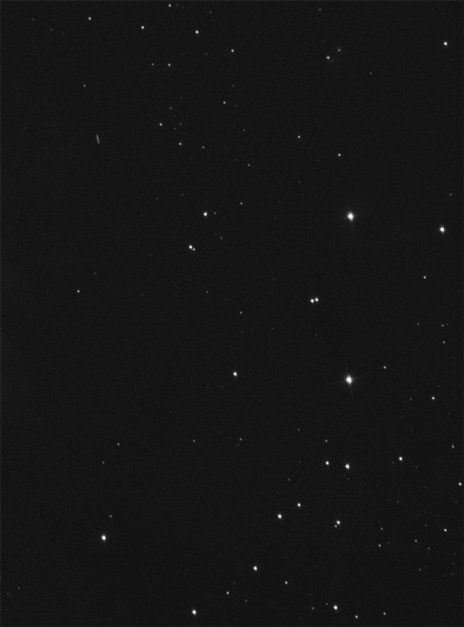
Just a quick addition, my NGC1788 is an Astrobin top pick now.
Makes for a warm fuzzy glow for the last two months, two top picks (I am told the M78 only just missed out on being an image of the day) an unplanned “Target of opportunity” comet image, including an ISS transit across the comet in one sub plus a lucky capture of the JWST during an image run for M78.
A bit more warm and fuzzy, my NGC1788 image is the Astrobin image of the day today.
Congratulation Paul … this is well deserved.
Incredible image.
We have pubblished on our social page.
All the best
Leonardo
Thanks Leonardo. IOTD was a pretty tough nut to crack, as it should be with the quality of images you see there on Astrobin.
I have been working on another image but I am not quite happy yet with my processing, I may go back to the basic integration and start again. This is a crop from a four panel mosaic, the first I have planned properly ahead of time and used the research and survey/mosaic section to shoot. Normally I have started an image and then had to resort to all sorts of manual messing around to build it into a mosaic afterwards. The R&S/Mosaic section made this dead simple to shoot, I simply changed my generic dragscript to call the mosaic instead of a normal sequence and set it to image 5 subs each panel (Using my OSC camera) with infinite loop selected, until I had enough good subs on all four panels to be satisfied. I would have shot more but I started this quite late in the season.
I don’t think I need to describe what this is a mosaic of.
Latest image and lucky enough to be another Astrobin top pick. “Reflections and dust”. Shot with my Stellarvue SVX80T, 0.8 focal reducer and ASI2600MC Pro camera, 131 X 300 second exposures.
This is an area broadly part of the Chaemelion molecular cloud complex which is near the south celestial pole and contains reflection nebulae CED110, 111 and 112, two of which are only described as reflection nebulae and the third as “Interstellar matter” so there is little information about cataloged objects in this area. One other that is listed is a galaxy, NGC3620. This really benefited from 131 exposures compared to my first process of it at 100 so given I don’t really have any specific target plans for the refractor right now I might spend the next new moon on it and really push up the sub count to see where it stops improving.
Astrobin version at higher resolution. Reflections and dust ( Blue ) - AstroBin
Great image and processing!!
Thanks, the dusty areas are a challenge, it is very easy to turn them in to a noisy mess.
